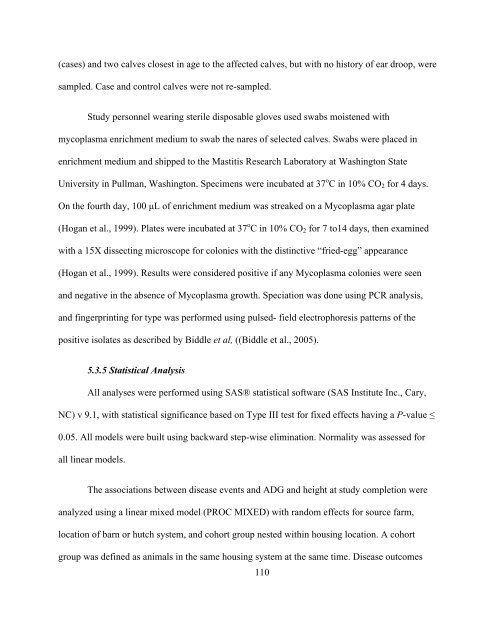Stanton PhD Thesis final_docx - Atrium - University of Guelph
Stanton PhD Thesis final_docx - Atrium - University of Guelph
Stanton PhD Thesis final_docx - Atrium - University of Guelph
Create successful ePaper yourself
Turn your PDF publications into a flip-book with our unique Google optimized e-Paper software.
(cases) and two calves closest in age to the affected calves, but with no history <strong>of</strong> ear droop, were<br />
sampled. Case and control calves were not re-sampled.<br />
Study personnel wearing sterile disposable gloves used swabs moistened with<br />
mycoplasma enrichment medium to swab the nares <strong>of</strong> selected calves. Swabs were placed in<br />
enrichment medium and shipped to the Mastitis Research Laboratory at Washington State<br />
<strong>University</strong> in Pullman, Washington. Specimens were incubated at 37 o C in 10% CO2 for 4 days.<br />
On the fourth day, 100 µL <strong>of</strong> enrichment medium was streaked on a Mycoplasma agar plate<br />
(Hogan et al., 1999). Plates were incubated at 37 o C in 10% CO2 for 7 to14 days, then examined<br />
with a 15X dissecting microscope for colonies with the distinctive “fried-egg” appearance<br />
(Hogan et al., 1999). Results were considered positive if any Mycoplasma colonies were seen<br />
and negative in the absence <strong>of</strong> Mycoplasma growth. Speciation was done using PCR analysis,<br />
and fingerprinting for type was performed using pulsed- field electrophoresis patterns <strong>of</strong> the<br />
positive isolates as described by Biddle et al, ((Biddle et al., 2005).<br />
5.3.5 Statistical Analysis<br />
All analyses were performed using SAS® statistical s<strong>of</strong>tware (SAS Institute Inc., Cary,<br />
NC) v 9.1, with statistical significance based on Type III test for fixed effects having a P-value ≤<br />
0.05. All models were built using backward step-wise elimination. Normality was assessed for<br />
all linear models.<br />
The associations between disease events and ADG and height at study completion were<br />
analyzed using a linear mixed model (PROC MIXED) with random effects for source farm,<br />
location <strong>of</strong> barn or hutch system, and cohort group nested within housing location. A cohort<br />
group was defined as animals in the same housing system at the same time. Disease outcomes<br />
110

















